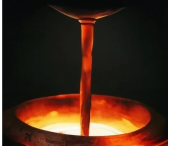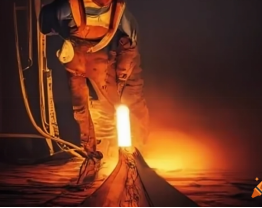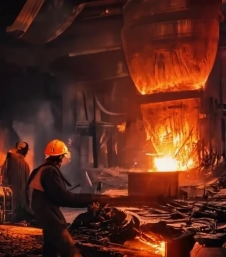Stainless Steel Melting Point: An Essential Guide for Mechanical Engineers
 May 29,2024
May 29,2024

Stainless steel has a range of composition depending on the demands. Based on microstructures, these are like austenitic grades (316, 304), ferritic grades (430, 434) and martensitic grades (410, 420). Similarly, they can be categorized as alloying elements additions. They all have different mechanical and corrosion properties. Now, the question arise here are all these grades have same melting point? If different, then what feature makes it different and if same then how other things are different? This article will highlight important points about the melting point of stainless steel.
Introduction to Stainless Steel
Stainless steel is famous for its great mechanical properties and corrosion resistance. The addition of alloying elements further improves its properties such as Ni, Co, Mb, Ti etc.

Origins and Composition
Stainless steel was made in the early 1900s. in 1912, an English researcher, Harry Brearly, made a discovery by experimenting steel with different composition. After that, its advancements lead to industrialization. It primarily consists of iron, chromium and carbon. Alloying elements are added to further increases its properties. Mostly the composition is dependent on the application and project cost. The main element in Cr in this alloy provides corrosion resistance.
Common Applications in Manufacturing
The uses of stainless steel in different industries are as:
- Manufacturing
All kinds of manufacturing industries like automotive, aerospace, aeronautics and marine, all require stainless steel. This provides tensile strength, heat resistance, corrosion resistance, durability and is a cost-effective option. stainless steel bars are used to make engines, exhaust system, transmission and other parts for support system of structure.
- Construction
stainless steel is the main material for reinforcing concrete structure in construction. It provides support for roof, buildings and bridges. Stainless steel alloys are used to join concrete and support pavements and highways.
- Food industry
Stainless steel alloys are easy to clean and can maintain hygiene. This feature is most demandable in food industry. It is also used to make appliances and its corrosion resistance is ideal for processing liquid food and beverage.
- Pharmaceutical and medical
Stainless steel alloys have an exceptional ability to withstand body fluid. Its corrosion resistance and tensile strength are ideal for body implants. It is also used to make surgical tools.
- Energy sector
The energy sector is highly dependent on steel alloys due to high heat resistance and high service temperatures. The melting point of stainless-steel alloys is very high. These are used to make heat exchangers, conders and boilers.
Understanding the Basics of Melting Points
To understand the basic knowledge of melting point, it is important to first know its definition.
What is the Melting Point?
It is the temperature at which solid melts to liquid. The melting point of crystalline material is used to identify the pure compound and element. Most amorphous material melts over a range of temperature. Material at its melting point can exist in equilibrium state.
Stainless Steel Melting Point in Detail
As for the many steel alloys, stainless steel melting occurs at a range of temperatures. It is not just a melting point of stainless steel. stainless steel melting occurs from 1400-1530℃. Iron has melting point of 1535℃. Similarly other elements in stainless steel like Cr has 1890℃ and Ni has 1453℃. Therefore, each grade has different melting point. depending on the amount of alloying element, exact melting point of stainless steel differs from different grade.

What Temperature Does Stainless Steel Melt?
Melting of stainless steel starts from 1400℃ to 1530℃. Each grade has a different melting point depending on its composition.
Melting Points of Common Stainless Steel Grades
|
Stainless steel grades |
Melting range |
|
1018 |
1480-1525℃ |
|
1030 |
1380-1510℃ |
|
201 |
1400-1450℃ |
|
301 |
1400-1420℃ |
|
303 |
1400-1420℃ |
|
304 |
1400-1450℃ |
|
304L |
1400-1420℃ |
|
316 |
1375-1400℃ |
|
316L |
1375-1400℃ |
|
321 |
1400-1425℃ |
|
410 |
1425-1510℃ |
|
413 |
1480-1530℃ |
|
416 |
1480-1530℃ |
|
420 |
1450-1510℃ |
|
430 |
1425-1510℃ |
|
440 |
1370-1480℃ |
|
440c |
1370-1480℃ |
|
446 |
1425-1510℃ |
|
630 |
1370-1420℃ |
|
2205 |
1385-1445℃ |
Comparison with Other Materials
Metals and alloys have different melting point. As discussed above, stainless steel melting done at 1400-1530℃. Carbon steel has slightly higher melting point of 140-1550℃. Cast iron has 1200℃ melting point. Copper melts at 1080℃. Chromium melts at around 1800℃. Nickle melts at 1452℃. Aluminum has 680℃ melting point. Among metal tungsten has highest melting point 3400℃. Mercury has the lowest melting point -39℃.

Factors Influencing the Melting Point of Stainless Steel
Role of Alloying Elements
Addition of alloying elements normally reduces the melting point of steel alloys. As iron has 1550℃ melting point. In addition, alloying elements like Ni and Cr have a higher melting point than stainless steel. However, stainless steel has 1400-1530℃ melting range. At higher temperatures, alloys tend to lose their tensile strength. Therefore, the service temperatures are kept below the melting point of material.
Impact of Manufacturing Processes
Metling and manufacturing processes are successfully carried out when the right temperature is selected. Melting temperature has an influence on the final product. It has an impact on primary process like forging, rolling, drawing. Due to different melting points of each metal in an alloy, manufacturing processes have a tolerance. That is why it covers a range of temperature and not just a point.
Practical Applications and Considerations
Welding and Melting Points
Heat as an arc or flame is important to melt the base metal in welding. The important consideration of heat input is the cooling rate of welds. This can have adverse effects on microstructure of heat-affect zone. At lower temperatures, welds are most likely to crack or wrap because of high cooling rate. These all points are related to the melting point of base material. stainless steel generally has a higher melting range than welding. Therefore, most properties are not compromised during welding.
Forming Processes Influenced by Melting Point
Strength of stainless steel is reduced at higher temperatures. therefore, service temperatures are very less than melting points instead of having high heat resistance. The changes of properties can result in less forces during forming. But ductility is high at higher temperature which helps in plastic deformation of stainless steel.
Advanced Topics in Stainless Steel Melting Points
High-Performance Alloys
High performance stainless steel like duplex steel has 1410-1460℃ melting range. Higher strength alloys are normally not recommended for high service temperatures operation even though they have high heat resistance. This is due to the occurring of precipitation hardening at higher temperature.
Melting Behavior Under Different Conditions
Heat treatment or cold working can be advantageous in the temperature range of elastic deformation of steels at 480℃. This increases the strength of material. but the steels like duple steels can suffer embrittlement at 350℃. This alloy has high oxidation resistance due to high Cr content but has limited applications.
Conclusion
Stainless steel melting occurs at 1400-1550℃. Each grade has a different melting point due to different alloying composition. stainless steels are known for high tensile strength, corrosion resistance and heat resistance. The service temperature of stainless steel is far less than melting temperatures. This is because the mechanical properties and corrosion properties are reduced at higher temperatures. therefore, the material is designed based on service temperature and not melting point of stainless steel.
 Tel/WeChat:
Tel/WeChat:  Email:
Email: 
 Home
Home
 Acetal vs Delrin: A Comprehensive Comparison for Manufacturing and Mechanical Design
Acetal vs Delrin: A Comprehensive Comparison for Manufacturing and Mechanical Design 







